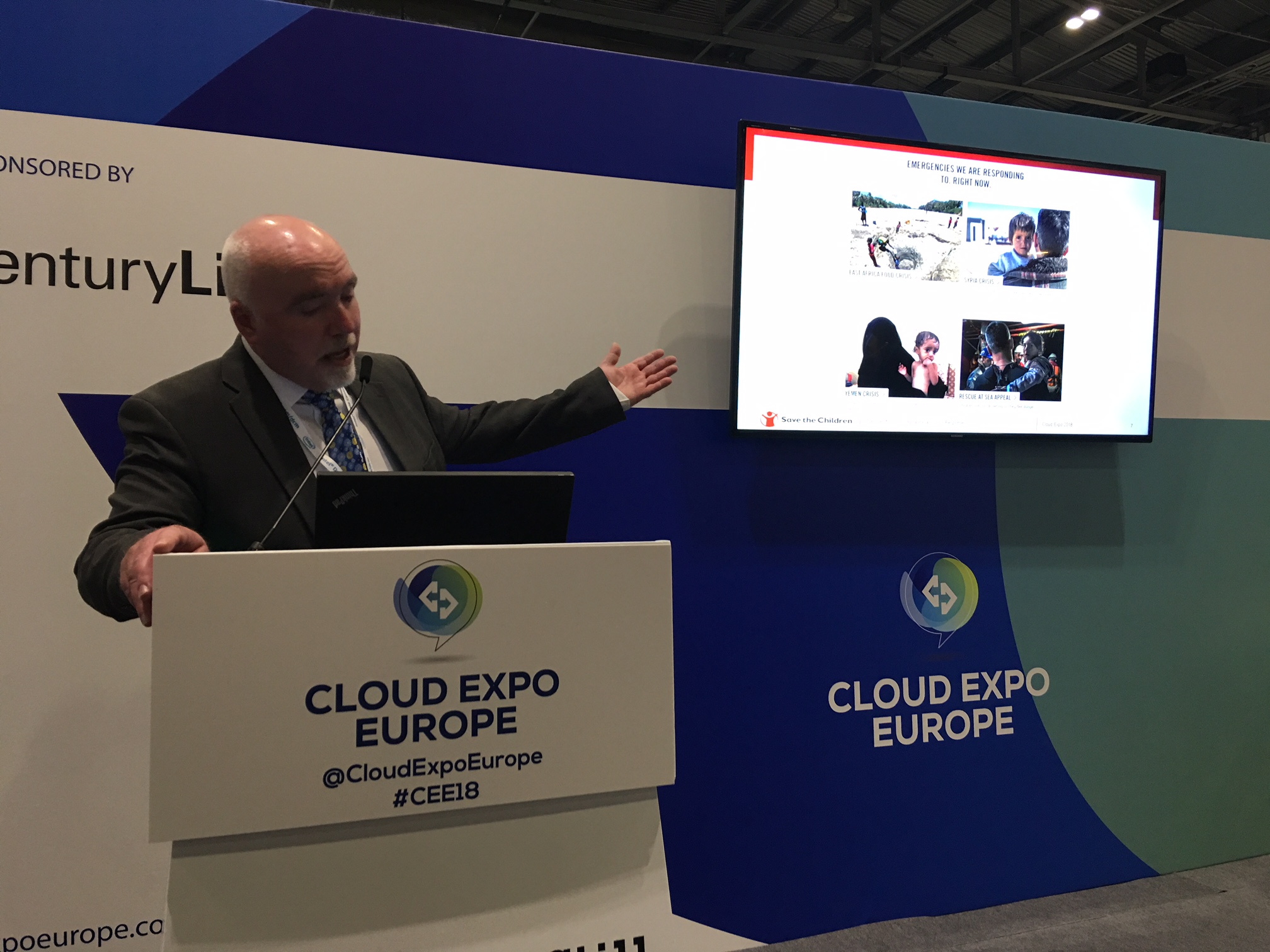Save the Children: How cloud helps in disaster zones
Charity's head of IT deploys cloud to mobilise quickly in humanitarian disasters


The cloud can greatly benefit charities trying to help people around the world in humanitarian disasters, according to Save the Children's head of IT.
For the charity's teams deployed in disaster zones, time is of the essence, and they need to do whatever it takes to save children's lives delivering life-saving food, water, healthcare, protection and education, said Gerry Waterfield, head of global IT services at Save the Children International, speaking at Cloud Expo Europe in London today.
Using different cloud services, the charity can mobilise quickly and securely without having to deploy preconfigured devices with its line-of-business suite of applications, Waterfield said. Being able to deploy this so quickly can mean the difference between life and death.
"The work we do is in very difficult locations, so we have to think about connectivity, it is one of the biggest issues we face before we use the cloud," he said. "The other issue is having power; if there is no power, there is no connectivity, hence no internet."
The charity works in more than 120 countries around the word and helped 22 million children in 2016. Waterfield said that bandwidth is frequently at a premium and the charity is heavily reliant on costly satellite communications, so the use of lightweight web apps is important.
In order to get power, and thus connectivity, Save The Children has looked at using solar power because of the amount of sunlight available in a lot of areas where it works.
Wit so many refugees fleeing war over the Mediterranean Sea, having connectivity at sea means that the charity can access real-time weather data from the cloud as well as data on numbers making the dangerous journey across this stretch of water so that the charity is better able to be in the right place to offer assistance.
Get the ITPro daily newsletter
Sign up today and you will receive a free copy of our Future Focus 2025 report - the leading guidance on AI, cybersecurity and other IT challenges as per 700+ senior executives
To that end, Waterfield said that the charity has used Office 365, as it can be rolled out everywhere to any device. It has also used a cloud-based HR system from Oracle. Waterfield said this has been helpful in emergency situations where volunteers have to be assembled quickly and onboarded as well as in helping select the right people for the right roles on the ground.
Save the Children has also used Kobo Toolbox, to allow workers in emergency situations create ad-hoc reports, and Facebook's Workplace as an enterprise social network to allow workers to exchange information more quickly about situations and projects.
Going forward, Waterfield said that he would like to see the charity be able to use more technology in the field as this would help more people in crisis situations.
Rene Millman is a freelance writer and broadcaster who covers cybersecurity, AI, IoT, and the cloud. He also works as a contributing analyst at GigaOm and has previously worked as an analyst for Gartner covering the infrastructure market. He has made numerous television appearances to give his views and expertise on technology trends and companies that affect and shape our lives. You can follow Rene Millman on Twitter.
-
 Should AI PCs be part of your next hardware refresh?
Should AI PCs be part of your next hardware refresh?AI PCs are fast becoming a business staple and a surefire way to future-proof your business
By Bobby Hellard Published
-
 Westcon-Comstor and Vectra AI launch brace of new channel initiatives
Westcon-Comstor and Vectra AI launch brace of new channel initiativesNews Westcon-Comstor and Vectra AI have announced the launch of two new channel growth initiatives focused on the managed security service provider (MSSP) space and AWS Marketplace.
By Daniel Todd Published
-
 How to empower employees to accelerate emissions reduction
How to empower employees to accelerate emissions reductionin depth With ICT accounting for as much as 3% of global carbon emissions, the same as aviation, the industry needs to increase emissions reduction
By Fleur Doidge Published
-
 Worldwide IT spending to grow 4.3% in 2023, with no significant AI impact
Worldwide IT spending to grow 4.3% in 2023, with no significant AI impactNews Spending patterns have changed as companies take an inward focus
By Rory Bathgate Published
-
 Report: Female tech workers disproportionately affected by industry layoffs
Report: Female tech workers disproportionately affected by industry layoffsNews Layoffs continue to strike companies throughout the tech industry, with data showing females in both the UK and US are bearing the brunt of them more so than males
By Ross Kelly Published
-
 How can small businesses cope with inflation?
How can small businesses cope with inflation?Tutorial With high inflation increasing the cost of doing business, how can small businesses weather the storm?
By Sandra Vogel Published
-
 How to deal with inflation while undergoing digital transformation
How to deal with inflation while undergoing digital transformationIn-depth How can organizations stave off inflation while attempting to grow by digitally transforming their businesses?
By Sandra Vogel Published
-
 How businesses can use technology to fight inflation
How businesses can use technology to fight inflationTUTORIAL While technology can’t provide all the answers to fight rising inflation, it can help ease the pain on businesses in the long term
By Sandra Vogel Published
-
 Embattled WANdisco to cut 30% of workforce amid fraud scandal
Embattled WANdisco to cut 30% of workforce amid fraud scandalNews The layoffs follow the shock resignation of the company’s CEO and CFO in early April
By Ross Kelly Published
-
 Ciphr appoints new sales chief as part of double leadership shakeup
Ciphr appoints new sales chief as part of double leadership shakeupNews Former GoTo executive Gerald Byrne will lead all sales activity at the HR and payroll solutions provider
By Daniel Todd Published